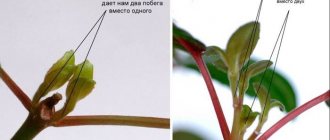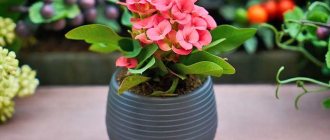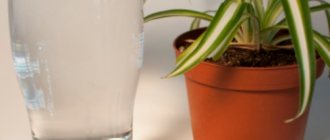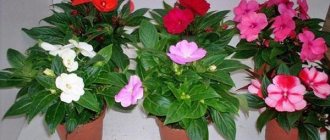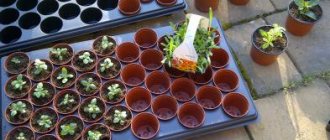With the onset of frost outside, around October, ornamental shrubs and flowering pots begin to prepare for winter, even if they have been growing indoors all year. For many plant species this is a period of dormancy, but for some, on the contrary, in winter they begin to bloom and replace their “summer neighbors” on the window. Despite the transition to a new regime and the slowdown in growth, home flowerpots need to continue to be looked after. Let's consider how to care for indoor plants in winter.
Preparing for winter in the fall
From September to October, the days are shorter, the weather changes, and it becomes colder. From this time on, indoor flowerpots must begin to be switched to winter mode. During the cold season, the vegetative processes of most deciduous plants slow down, and in some they stop altogether. For the winter, deciduous flowerpots are put away in a dark, cool place from the end of autumn, where they wait for spring.
To prevent flowers from experiencing stress from sudden changes in growing conditions and cold, they can be helped to “get ready to relax.” To do this, they stop feeding them, especially with nitrogen-containing fertilizers, water less frequently, moisten them and protect them from drafts.
Plants that need rest for the winter
Most bulbous and all tuberous flowers must go through winter dormancy. In autumn, their leaves naturally turn yellow and fall off or wither; you need to wait for this process and then cut the stems, leaving 2 - 3 cm.
Among the cold-loving ones, flowering ones are distinguished: tuberous begonia, fuchsia, hippeastrum, hydrangea, gloxinia, hyacinths and others.
After pruning, the plant must be treated with solutions of fungicides and insecticides to destroy and prevent diseases, fungi and pests. The roots are then stripped or left in the pot and transferred to a cool, dark place for storage. The temperature is about +5 - +10, and the roots need to be moistened periodically so that they do not dry out. Avoid overwatering, otherwise they will rot and die.
Protect indoor plants from hypothermia and overheating
garden-zoo.ru
An important point in winter maintenance of plants is the air temperature in the room. It should not fall below 15°C, with the exception of tuber crops, for which a cool winter, on the contrary, is indicated. More often, plants suffer from overheating when they stand on a windowsill with a radiator under it. Therefore, it is advisable that there be at least 15-20 cm from the heat source to the pot.
The leaves of indoor plants should not touch the glass, otherwise in frosty weather the flower may receive cold stress, which will affect not only its above-ground part, but also the root system. Be sure to insulate window cracks if there is draft from them, and place pots on foam or wood stands.
It is better to remove flowers from the windowsill while airing, because... an icy draft is fatal for them. If there are a lot of flowers, or you often ventilate the room, it is better to move the pots deeper into the room and illuminate them with a phytolamp. Or, if possible, open only those windows next to which there are no plants.
How to care for plants on the windowsill in winter?
If the flowerpots do not shed their leaves and continue to turn green in pots, caring for them in cold weather still changes. Changes such as short daylight hours, cold from windows and warm, dry air from heating radiators affect plants, causing them to slow down their development. Caring for them will depend on the type - heat-loving, cold-loving or unpretentious, as well as on the conditions of detention.
Azaleas, indoor roses, poinsettias, Decembrists, cyclamens, guzmans and orchids bloom in winter. Therefore, they require careful treatment, good lighting and watering.
Green shrubs and ornamental trees tolerate cold and cloudy times well, but remain in the room. These include palm trees, aloe, dracaena, cyperus, asparagus, sansevieria, agaves, ivy and ficus.
Succulents and conifers need to be watered rarely when the soil is dry. These include sweatshirt, cactus, boxwood, aloe, milkweed and kalanchoe.
Caring for plants in winter in an apartment also depends on:
- room temperature,
- ventilation frequency,
- type and location of heating devices,
- quality of window structures and air humidity,
- lighting level.
These factors influence how often to water, add light and spray the flowerpots. This is as important as the natural differences between different plant species.
In order for the flowers to survive the winter well and remain healthy, it is necessary to properly care for them.
Provide indoor plants with adequate lighting
narnewsline.blogs.realtor.org
A sufficient amount of light is one of the conditions for good health of indoor flowers. But while it is quite easy to provide plants with proper watering in winter, problems often arise with lighting. Here's what to do in this situation:
- place the plants on the brightest window sill in the apartment (south or east);
- keep the glass clean: the cleaner it is, the more light gets to the plants;
- Rotate the pot several times a month so that the flower does not stretch and all its parts are illuminated evenly.
If, despite all these rules, the plant turns pale, its leaves become smaller, you will have to purchase a phytolamp and provide additional illumination.
Caring for indoor plants in winter
Let’s look separately at the conditions that need to be created for flowerpots at home during the cold season for successful wintering.
Watering
During winter care, indoor plants need to be watered less than in summer. This is due to the fact that they are in a “sleepy state” and grow slowly, and the temperature of the soil in the pot decreases. Stagnation of water will quickly lead to rotting of the roots and loss of the flower.
Proper watering is carried out rarely, but abundantly. The pot should have a good drainage layer so that excess water flows freely into the tray and is removed. If you water in scanty portions and at long intervals, the earthen ball simply dries out, moisture flows out without moistening it and the roots are not nourished.
Important! On average, flowerpots need to be watered once a week. For this, settled water is used at a temperature slightly above room temperature - 25 - 30 degrees. Cacti don't need to be watered at all.
Humidity
Heating radiators dry out the air, so indoor plants in winter must be frequently sprayed with a spray bottle. If these are flowers with “fluffy” leaves, like gloxinia or violet, they should not be wetted. In this case, you need to spray away from them.
The best way to maintain good humidity in a room with flowers is to turn on a humidifier. The reading on the hygrometer should reach 40-60%.
Lighting
In winter, all plants lack natural sunlight, since daylight hours are very short. The lack of lighting is visible in the state of the flowers themselves. Their stems begin to stretch, the foliage becomes smaller, and the color fades. Flowerpots may not bloom if they are not provided with 14 hours of daylight. Plants with variegated leaves, such as croton, fittonia, heptapleurum, hipestes or arrowroot, with a lack of direct sunlight, darken and lose color.
In order for variegated or flowering indoor plants to grow well in winter, they need to be supplemented with light. To do this, use a special LED phyto-lamp with a violet glow or a regular fluorescent daylight lamp. Provide additional light for 5-6 hours every day and reduce this time as daylight hours lengthen. Place the lamp above the plants at a distance of 60 cm for green ones and 20 - 30 cm for flowering flowerpots.
Leaves must be periodically cleaned of dust. For smooth foliage, use a damp cloth, and for soft foliage, use a warm shower. Dust prevents plants from breathing and drowns out light.
Top dressing
There is no need to feed house flowers in winter. If you want to strengthen the plants during the winter flowering period, the recommended dose should be reduced by 2 times and fertilized no more than once a month.
Do plants need fertilizer and feeding in winter?
Experienced flower growers give a clear answer to this question: dormant indoor plants should not be fertilized. Fertilizers are applied only during the growing season, when the flower begins to actively grow.
How to understand that fertilizing is required in winter
It may happen that the plant itself will “tell” when it needs to be fed. Signs of “starvation” may be:
- slowing or stopping growth,
- dwarfism,
- in flowering specimens there is no flowering,
- blanching or spotting of foliage.
However, according to experts, simply normal care of indoor plants in winter is much more important than conventional liquid fertilizers.
General rules for fertilizing houseplants
In order not to harm your green pets, you need to know how to properly feed indoor plants in winter.
- To avoid burns to the roots, fertilizers are applied only to moist soil. About 30 minutes before applying fertilizer, the soil in the pot should be watered with clean water.
- It is best to do this in the evening.
- After fertilizing with liquid fertilizers, which form a thin film on the surface of the soil, it is recommended to loosen the soil in the pot to allow air to reach the roots.
- It is enough to feed once every two weeks, fast-growing ones - once every ten days.
- You cannot fertilize plants immediately after transplanting/transferring. This can be done in three weeks.
- You should also not fertilize sick plants, so as not to take away additional strength from them.
- We must try not to get the nutritious, usually very concentrated, solution on the foliage and flowers of plants. A lower concentration fertilizer solution can be used for foliar feeding.
For your information! An excess of one or another element can cause undesirable effects. Thus, excess nitrogen causes active growth in indoor plants, but flower buds do not appear and the plant does not bloom. In order for it to bloom, it is necessary to feed it with potassium-phosphorus fertilizer.
Why do the leaves of indoor plants turn yellow? Their yellowing and faint color of the flowers indicate an excess of potassium. Excess phosphorus provokes discoloration of foliage and early aging of the plant.
Types of winter fertilizers for indoor plants
Many amateur gardeners prefer to feed indoor plants in winter with home remedies, which are available to everyone and are not inferior in usefulness to “chemistry”. How to feed indoor flowerpots?
- You can make fertilizer from banana peels by drying and grinding them or making an infusion. It serves as a good potassium fertilizer.
- The water in which cereals (buckwheat, pearl barley, millet, rice) were soaked and washed is very beneficial for plants. It is recommended not to drain the water, since “cereal” microparticles contain many nutrients, but to fertilize the plants with it.
- No less useful is another water - from an aquarium, which is a fertilizer rich in microorganisms, and it is also free. Aquarium plants also feed on the remains of fish life processed by these microorganisms.
- A nutrient solution based on aloe juice is also recommended. To prepare the juice, cut off the lower large leaf of the plant, peel it, cut it into small pieces and squeeze the liquid through cheesecloth. A two-liter vessel only needs one and a half teaspoons of juice. It is necessary to water immediately after cooking, otherwise the content of nutrients will decrease.
- An environmentally friendly, natural and affordable fertilizer is obtained from an infusion of pomegranate and citrus peels.
- The nutritional properties of wood ash are well known. One tablespoon of ash is poured into a liter of water and left for two days, filtered, and a couple of crystals of potassium permanganate and drops of iodine are added.
For the care and proper care of indoor plants in winter, by spring they will thank the owner with a luxurious head of foliage and abundant flowering.
Pests and their control
Overwintering plants are quite sleepy, but pests do not sleep. They are active at any time, so you should carefully monitor so that they do not kill your pets. Wash them off with a regular shower, wipe large flower leaves with soap and water, and use special pest control products. You can buy them at a flower shop.
When air dryness increases, spider mites become more active. You can try a homemade recipe against it. Finely chop the garlic and onion and cover them with water. Leave it to brew for several hours. Strain the resulting infusion. They need to spray the flowers a couple of times a week. It is also recommended to immediately increase the humidity in the room where there is a tick.
Fungus and rot are also dangerous in winter. This is especially true when the room is cool and the soil dries out slowly. Dampness appears, which allows fungi to actively develop. In such cases, you should stop constantly watering the plants. Add moisture only when the soil is dry.
It can be difficult for plants to overwinter. Too many negative factors fall on them with the onset of cold weather. Therefore, it is so important to care for indoor flowers correctly in winter. Not only their appearance, but also their health depends on this.
Your care and compliance with all the rules will help indoor flowers to withstand the cold as easily as possible. And then, with the onset of spring, you will be able to appreciate and enjoy their beauty and aroma. In addition, in gratitude for proper care, flowers will always maintain a favorable atmosphere in your home.
Fight diseases
A decrease in temperature, humidity and non-compliance with watering schedules in winter often cause infection of indoor plants. Weakened, hibernating flowers may not survive the winter due to rotting roots or insect infestation.
Spider mites and mealybugs prefer dry air to humid air, which are especially active in winter. Due to their small size, it is quite difficult to quickly detect pests. They can hide in the soil, in the axils or on the back of the leaf. In order not to waste the moment when the number of pests has not grown to the level of the colony, it is important to carry out a number of preventive measures:
- Increase air humidity levels;
- Carefully inspect the plant;
- Wash the leaves with soapy water.
It is recommended to remove infected leaves immediately and treat the cut with an antibacterial compound.
Diseases and pests
Winter is a favorable time for scale insects and spider mites, which prefer dry air. Pests become most noticeable in winter, because the plant does not grow, and the pests constantly multiply.
They are fought with the help of such folk methods as turpentine, kerosene-soap mixture, and garlic extract. The infected plant is sprayed and washed every other day with clean water.
If the plant is attacked by pests and cannot be sprayed, then apply garlic vapor. Finely chop the garlic, placing it on a saucer and placing it near the pot with the plant. The flower in the pot and the saucer with garlic are covered with a whole bag, preventing the penetration of air. Remove the bag after three hours.
Scale insects are removed from plants using a cotton swab moistened with alcohol (cologne). Places where scale insects accumulate are treated with infusion of citrus fruits and garlic.
An effective method is to use shag (tobacco) tincture and laundry soap. To prepare the tincture you need to take 3-2 grams of soap, 0.5 liters of water, 1 tbsp. l. tobacco
Garlic tincture gives excellent results. The head of garlic is ground and filled with water (1 liter) and left for 24 hours. The resulting solution is sprayed onto the plants.
Diseases that occur in winter are various rots of bacterial origin. Low temperature and abundant watering provoke the appearance of rot. Therefore, reducing moisture in winter is an important factor in caring for indoor plants.
Home flowers winter care in December
Indoor plants that stand on window sills are placed on stands 2-3 cm high made of wood (plexiglass) to avoid overcooling of the roots. Plants from the battery are protected with plywood shields.
Fuchsia, oleander, pelargonium are placed in a cold room and watered moderately.
The hippeastrum is moved as close to the window as possible. When the flower shoot reaches a height of ten centimeters, the flower begins to be watered, allowing the substrate to dry, with warm water. The pot with hippeastrum is rotated around its axis from time to time. In this case, the peduncle will grow straight.
To avoid dropping buds, do not move the zygocactus.
Cyclamens are placed on southern (eastern) window sills. Watering the bottom with warm, settled water. The temperature of the cyclamen content is 15…18°C.
Saintpaulias that have completed their flowering are placed in a cool, bright place. Loosen the substrate in the pots and lightly moisten it. If you want to prolong the flowering of Saintpaulia, add additional lighting. The photoperiod should be 12..14 hours.
Cyperus is watered abundantly, making sure to drain off excess moisture.
Curculigo (adults) are rarely watered in winter, since regular watering causes the roots of the plant to rot.
Monstera, scindaptus, and philodendron growing in winter are watered and fertilized with mineral fertilizers in low concentrations.
Adiantum and nephrolepis are placed in the most illuminated place. To prevent the fern from dying in winter, it is sprayed daily, the substrate is periodically moistened, and it is not allowed to dry out.
Orchids that have already developed flower stalks are placed in a cool, well-lit place. When watering, monitor the condition of the bulbs. The bulbs should not be allowed to become wrinkled. Orchids that do not produce flower stalks are watered extremely sparingly.
Azaleas and camellias are kept at a temperature of 18-23 °C, watered and sprayed daily.
Attention! Indoor flowers that bloom in winter will not shed their buds if they are kept at a temperature of 12..15 °C.
At the end of December, Achimenes rhizomes and Gloxinia tubers are planted in pots with loose soil.
Take care of the cleanliness of indoor plants. Wipe off the dust from the leaves with a soft cloth and spray. Using a brush, brush away dust from plants with pubescent leaves.
In order to prevent the appearance of pests, the plant is washed with cool water.
Change the feeding regime for indoor plants
articulo.mercadolibre.com.mx
Indoor plants that are dormant do not need feeding. By the beginning of the winter season, gradually reduce the amount of fertilizer applied. It will be possible to resume the procedures only in early spring, when new leaves appear on the plants. As before, you should only feed winter-blooming crops: Schlumbergera (Decembrist), Kalanchoe, spathiphyllum, violet, etc.
Replanting indoor plants in winter is also unacceptable. Exception: root rot, when you urgently need to transplant the flower into fresh soil.
- How to feed indoor plants - choosing the ideal fertilizers for flowers on the windowsill
Do you want your plants to look healthy all year round? Then create the right feeding regimen for them!
Briefly about the main thing
Owners of decorative deciduous plants such as Ficus, Palm, Chlorophytum, Monstera, Spathiphyllum, Tradescantia and other hibernating plants are recommended to water no more than once a week or even two. In this case, these varieties should be removed from the main room to a cooler room with a temperature of 14...16 ° C, or regular foliar spraying or high-quality air humidification should be provided.
For succulents and cacti, as well as euphorbia, aloe, crassula, agave, etc., practically no watering is required from November to March. The soil in the pot is moistened only if it is completely dry (no more than once every 1...1.5 months). In this case, the pots with these plants are placed in fairly cool rooms with a temperature no higher than +13°C. The same is done with bulbous plants, which shed their leaves and enter the stage of suspended animation. However, sometimes (especially young) bulbous plants do not shed the vegetative part and live in their usual rhythm, then the watering schedule and other care rules do not change.
For actively flowering forms Decembrist, Violets, Camellia and others, the drinking ration remains at the usual strength: once every 2...4 days, depending on external conditions, as well as the condition of the plant itself.
For owners of any indoor plants, a simple method will always help to check whether the soil needs to be moistened: with a finger or a thin wooden splinter, you need to probe the earthen lump at a depth of 2...3 cm, if this layer is dry, then watering is necessary, if the soil is still damp, then you should not irrigate it. do not provoke the development of pathogenic microflora and rotting of the root system.
It would also be good advice to install a special humidifier next to the flowers, plant special sphagnum moss, or install a container of water so that the plants do not get thirsty in stuffy rooms with central heating.
It is also worth paying close attention to the water for irrigation. It should be: clean, soft, warm. In order to rid tap water of harmful impurities, it can be left in an open container for 12...24 hours or frozen in the freezer, and then thawed and slightly warmed up. The water temperature should be comfortable for the root system and not differ from the ambient temperature by more than 1...2 degrees.
By understanding the question of how to water flowers correctly in winter, you can grow a beautiful home greenhouse from luxurious decorative foliage and wildly flowering plants.
How often to spray
If your home flower loves spraying, then you should not neglect this procedure, especially in winter, when central heating mercilessly dries out the air in the room. If the flowerpot is placed near or above the radiator, the air around it will be especially dry.
Miss Clean magazine advises removing flower pots away from heating systems, or placing humidifiers nearby, for example, a tray with wet moss and expanded clay.
Spray coniferous plants more often. Do not forget to remove dust from the foliage with a damp cloth, as it interferes with light access to the plant tissues.
Watering
Without proper care, indoor flowers and your hopes for a blooming indoor garden perish. Therefore, be patient and create as favorable a microclimate around your plants as possible. Necessary conditions include adequate and regular watering. When placing flowerpots in warm places, you sometimes risk overdoing it; if the plants do not have enough moisture, the soil dries out quite quickly. Follow a certain trend: spray more, water less. The only exceptions are those flowers that cannot tolerate moisture on the leaves - only their soil needs to be fed with water.
In winter, the substrate very often gets clogged. It becomes hard and does not allow air to pass through at all. To prevent this, try to loosen the soil from time to time, this will only enhance the effect of watering and spraying. What to do with flowers that cannot be sprayed? Let's take violets, for example. If you pour a lot of water on their leaves, they will immediately rot. Therefore, in winter, use small trays with pebbles or expanded clay: place them under a flower pot and constantly moisten them. The result will be the same as from spraying, but without harm to the violet leaves.
